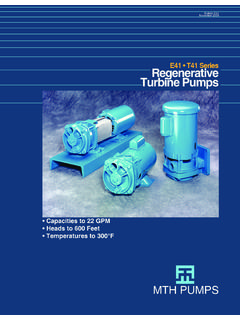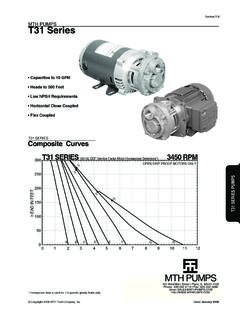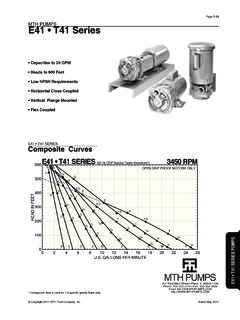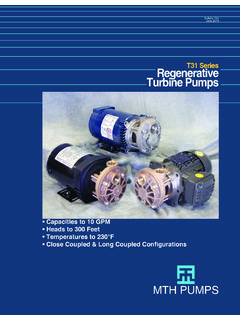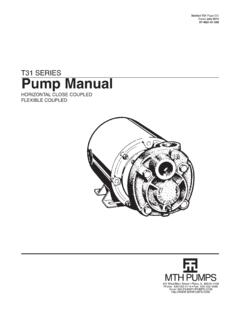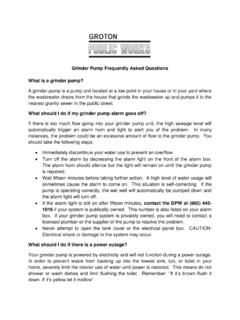Transcription of M50 • L50 SERIES Pump Manual - MTH Pumps
1 Section M50 L50 Page 501 Dated October 201097-4624-01-588M50 L50 SERIESPump ManualHORIZONTAL CLOSE COUPLEDVERTICAL CLOSE COUPLEDHORIZONTAL FLEXIBLE COUPLEDPage 502M50 L50 InstructionsHORIZONTAL CLOSE COUPLED PUMPSVERTICAL CLOSE COUPLED PUMPSHORIZONTAL FLEXIBLE COUPLED PUMPSA. Inspection of EquipmentB. StorageC. Placing Stored Pumps Into ServiceD. Application ConsiderationsE. Recommended Spare PartsWhen properly installed and given reasonable care and maintenance, regenerative turbine Pumps should operate satisfactorily for many years.
2 Because of the high differential pressures expected in a regenerative turbine pump, close running clearances are used to reduce internal losses. Abrasive particles, even microscopic ones, in high enough concentrations, can open up the close clearances between internal components. For critical services it is recommended that you keep an identical pump for stand-by Inspection of EquipmentImmediately upon receipt of the shipment, inspect the equipment for damage or missing components. Check the shipping manifest and report any damage or shortage to the Transportation Company s local agent.
3 Inspect the crate and any wrapping material before discarding. Parts or accessories are sometimes wrapped individually or fastened to the skid. Put the instructions that came with the shipment in a safe place where they will be available to those who will be using them for installation and StorageIf the pump is to be stored before use, it should be inspected as described in 1A, recrated and stored in a dry location. Standard shipping containers are not suitable for outdoor storage. In some areas, it may be necessary to cover the pump s exterior surface with oil or other rust inhibiting coating.
4 All units are tested at the factory with a water/corrosion inhibitor solution, some of which will remain inside the pump upon receipt. If units are flushed out prior to storage, this inhibitor will be removed and proper care must be taken to prevent product deterioration from improper storage beyond 30 days, a corrosion inhibiting protective fluid should be added to the internal pump cavities. Fluids used in the pump should be selected for compatibility with pump materials. This is very important when optional seal and gasket materials have been used.
5 Protective caps on the inlet and outlets should also be used. Caps alone are not sufficient Placing Stored Pumps Into ServiceSpecial care must be taken when placing stored Pumps into service. First clean the outside and flush out the inside with a process compatible fluid. Try to turn the pump using the coupling or shaft. On close-coupled units, access to the shaft is between the pump and motor. A vise grip or other plier type gripping device may be used directly on the shaft. Applying torque to the motor fan blades is not recommended.
6 If the impeller does not break loose immediately, fill the pump with a process compatible fluid and try again in a few this fails, read the disassembly-reassembly instructions. With an understanding of which are the bolts used to clamp the entire assembly together, loosen each of them exactly three full turns. After filling the pump with water again, up to 50 foot pounds of torque may be applied to the coupling or shaft without fear of ruining the impeller vanes. It should begin to turn well before this force is reached. Continue turning the pump while the various fasteners are returned to their original the unit still won t turn over, DO NOT apply further force.
7 Refer to the Disassembly/Reassembly Instructions in Section 5 to determine the cause of the Application Considerations1D1 Electrical WiringAll electrical equipment and wiring should conform to local and National Electrical Codes. Use the motor manufacturer s instructions for connecting the motor. Note the correct rotation and wiring diagrams on the assembly. Make sure the motor rotation and speed matches that required for the Construction MaterialsWhile it is reasonable to assume that good judgement has been used in selecting all the materials in the pump for compatibility with process fluids, actual conditions sometimes vary from original specifications.
8 Also, typical material selection charts do not consider all the temperature, pressure, and fluid variables. The customer s engineer should be consulted for final judgement on the best materials for critical process ValvesThe first valve to be considered for a regenerative turbine pumping system might be a pressure relief valve. Because this type of pump has a horsepower requirement similar to that of a positive displacement pump (constantly rising hp along with pressure increases) a relief valve can be effectively used to limit horsepower.
9 This is helpful when a non-overloading motor is specified. It can be of critical importance if the system flow rate can vary widely. There are almost no circumstances where a flow modulating valve will work successfully in a regenerative turbine pumping system. The steep pumping characteristic, typical of these Pumps , produces very large pressure changes with small variations in flow rate. As a result, the modulating flow from the valve introduces sharp pressure shock waves that shorten pump life and may cause damage to other pieces of equipment in the swing check valve is recommended in the suction line even when the pump inlet is only slightly higher than the fluid source.
10 It should be the same size as the pump inlet or sized based on reasonable fluid friction foot valve is recommended when lifting fluid from a sump. This will save wear and tear on any pump, even those equipped with self priming Y-Strainer is recommended immediately ahead of the pump on any newly constructed system. This is advisable due to the probability that foreign material large enough to damage pump clearances may remain even though the piping has been velocity in the pump. If a pump requires more energy (or NPSH) than is available at a given capacity, the pressure at the inlet will fall below the vapor pressure of the pumped liquid and loss of performance will result as the liquid = Pressure in the suction vessel in = Vapor pressure of the pumped fluid in = Static height of the pumped fluid above (+) or below (-) the centerline of the pump in = All friction losses from the vessel to the pump in = ( )+ Hs- HfFor boiling liquids, Ps and Pvp are equal.

